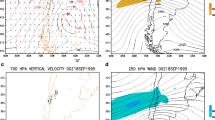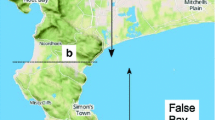Abstract
This study investigates the spatial structure and the seasonal occurrence of foehn wind to the east of the Andes using a flow blocking analysis in a 20-year climate simulation. The latter was performed by the Eta-CPTEC regional model at 50-km horizontal resolution. This version of the model includes a cut-cell scheme to represent topography and a finite-volume vertical advection scheme for dynamic variables. The results indicate that foehn wind more frequently blows during winter and spring on the eastern slopes of the Andes, except to the south of 37° S where it blows at all seasons. Higher mountains of the Central Andes (27° S–35° S) and the High Plateau (15° S–27° S) result in blocked foehn events, with a weak adjustment to the geostrophic balance. On the Central Andes, rain and snow on mountain tops may also contribute to generate foehn wind on the eastern slopes. The results show that a low pressure develops to the east of the Central Andes, and also to the east of the High Plateau when foehn blows. Lower mountains in Patagonia (to the south of 37° S) result in more frequent non-blocked foehn event, with better adjustment to the geostrophic balance.










Similar content being viewed by others
References
Antico PL, Chou SC, Mourão C (2017) Zonda downslope winds in the central Andes of South America in a 20-year climate simulation with the Eta model. Theor Appl Climatol 128:291–299. https://doi.org/10.1007/s00704-015-1709-2
Beusch L, Raveh-Rubin S, Sprenger M, Papritz L (2017) Dynamics of a Puelche foehn event in the Andes. Meteorol Z 27:67–80. https://doi.org/10.1127/metz/2017/0841
Brinkmann WAR (1971) What is a foehn? Weather 26:230–240. https://doi.org/10.1002/j.1477-8696.1971.tb04200.x
Chen F, Janjić ZI, Mitchell K (1997) Impact of atmospheric surface-layer parameterization in the new land-surface scheme of the NCEP mesoscale eta model. Boundary-Layer Meteorol 85:391–421
Dee DP et al (2011) The ERA-Interim reanalysis configuration and performance of the data assimilation system. Q J R Meteorol Soc 137:553–597
Ek MB, Mitchell KE, Lin Y, Rogers E, Grummen P, Koren V, Gayno G, Tarpley JD (2003) Implementation of NOAH land surface advances in the National Centers for Environmental Prediction operational mesoscale Eta model. J Geophys Res 108:8851. https://doi.org/10.1029/2002JD003246
Escobar CJE, Seluchi ME (2012) Classificação sinótica dos campos de pressão atmosférica na América do Sul e sua relação com as baixas do Chaco e do noroeste Argentino [Synoptic classification of the atmospheric pressure fields over South America and its relation to the Chaco and the Argentinean northwest lows, T]. Rev Bras Meteorol 27:365–375
Janjić ZI (1990) The step-mountain coordinate: physical package. Mon Weather Rev 118(7):1429–1443
Janjić ZI (1994) The step-mountain eta coordinate model: further developments of the convection, viscous sublayer and turbulence closure schemes. Mon Weather Rev 122:927–945
Janjić ZI (2002) Nonsingular Implementation of the Mellor-Yamada Level 2.5 Scheme in the NCEP Meso Model. NCEP Office Note, 61 p. https://www.emc.ncep.noaa.gov/officenotes/newernotes/on437.pdf
Lichtenstein ER (1980) La Depresión del Noroeste Argentino [The Argentinean northwest low, T]. Universidad de Buenos Aires. PhD dissertation. https://digital.bl.fcen.uba.ar/Download/Tesis/Tesis_1649_Lichtenstein.pdf
Mellor GL, Yamada T (1982) Development of a turbulence closure model for geophysical fluid problems. Rev Geophys Space Phys 20:851–875
Mesinger F (1993) Forecasting upper tropospheric turbulence within the framework of the Mellor-Yamada 2.5 closure. Res Act Atmos Ocean Model 18:4.28–4.29
Mesinger F (2010) Several PBL parameterization lessons arrived at running an NWP model. In: Intern. conference on planetary boundary layer and climate change, IOP Publishing, IOP Conference Series: Earth and Environmental Science 13. https://doi.org/10.1088/1755-1315/13/1/012005 (https://iopscience.iop.org/1755-1315/13/1/012005)
Mesinger F, Jovic D (2002) The Eta slope adjustment: contender for an optimal steepening in a piecewise-linear advection scheme? Comparison tests. NCEP Office Note 439. https://www.emc.ncep.noaa.gov/officenotes
Mesinger F, Veljovic K (2017) Eta vs. sigma: review of past results, Gallus-Klemp test, and large-scale wind skill in ensemble experiments. Meteorol Atmos Phys 129:573. https://doi.org/10.1007/s00703-016-0496-3
Mesinger F, Wobus RL, Baldwin ME (1996) Parameterization of form drag in the Eta Model at the National Centers for Environmental Prediction. In: 11th conference on numerical weather prediction, Norfolk. Am Meteorol Soc, pp 324–326
Mesinger F, Chou SC, Gomes JL, Jovic D, Bastos P, Bustamante JF, Lazic L, Lyra AA, Morelli S, Ristic I, Veljovic K (2012) An upgraded version of the Eta model. Meteorol Atmos Phys 116:63–79. https://doi.org/10.1007/s00703-012-0182-z
Montecinos A, Muñoz RC, Oviedo S, Martínez A, Villagrán V (2017) Climatological characterization of Puelche winds down the western slope of the extratropical Andes mountains using the NCEP Climate Forecast System Reanalysis. J Appl Meteorol Clim 56:677–696. https://doi.org/10.1175/JAMC-D-16-0289.1
Norte FA (1988) Características del Viento Zonda en la Región de Cuyo [Zonda wind features at Cuyo region, T]. University of Buenos Aires, PhD dissertation. https://digital.bl.fcen.uba.ar/Download/Tesis/Tesis_2131_Norte.pdf
Norte FA (2015) Understanding and forecasting Zonda wind (Andean Foehn) in Argentina: a review. Atmos Clim Sci 5:163–193
Norte FA, Ulke AG, Simonelli SC, Viale M (2008) The severe zonda wind event of 11 July 2006 east of the Andes Cordillera (Argentine): a case study using the BRAMS model. Meteorol Atmos Phys 102:1–14
Puliafito SE, Allende DG, Mulena CG, Cremades P, Lakkis SG (2015) Evaluation of the WRF model configuration for Zonda wind events in a complex terrain. Atmos Res 166:24–32. https://doi.org/10.1016/j.atmosres.2015.06.011
Reinecke PA, Durran DR (2008) Estimating topographic blocking using a Froude number when static stability is nonuniform. J Atmos Sci 65:1035–1048. https://doi.org/10.1175/2007JAS2100.1
Rutllant J, Garreaud R (2004) Episodes of Strong Flow down the Western Slope of the Subtropical Andes. Mon Weather Rev 132:611–622. https://doi.org/10.1175/1520-0493(2004)132<0611:EOSFDT>2.0.CO;2
Schwerdtfeger W (1976) Climates of Central and South America. In: Landsberg HE (ed) World Survey of Climatology. Elsevier, Amsterdam, pp 13–112
Seluchi ME, Norte FA, Satyamurty P, Chou SC (2003) Analysis of three situations of the Foehn effect over the Andes (Zonda wind) using the Eta-CPTEC regional model. Weather Forecast 18:481–501
Smith RB (1988) Linear theory of stratified flow past an isolated mountain in isosteric coordinates. J Atmos Sci 45:3889–3896
Würsch M, Sprenger M (2015) Swiss and Austrian foehn revisited: a Lagrangian-based analysis. Meteorol Z 24:225–242. https://doi.org/10.1127/metz/2015/0647
Zhao Q, Black TL, Baldwin ME (1997) Implementation of the cloud prediction scheme in the Eta model at NCEP. Weather Forecast 12:697–712
Zilitinkevich SS (1995) Non-local turbulent transport: Pollution dispersion aspects of coherent structure of convective flows. In: Power H, Moussiopoulos N, Brebbia CA (eds) Air pollution III. Air pollution theory and simulation, vol I. Computational Mechanics Publications, Southampton, pp 53–60
Acknowledgements
We are grateful to two anonymous reviewers for their valuable contribution to our work. We thank the editor, Fedor Mesinger, for his suggestions at the time of the manuscript revision. This research was partially supported by Conselho Nacional de Desenvolvimento Científico e Tecnológico grants 306757/2017-6, 400071/2014-2.
Author information
Authors and Affiliations
Corresponding author
Additional information
Responsible Editor: F. Mesinger.
Publisher's Note
Springer Nature remains neutral with regard to jurisdictional claims in published maps and institutional affiliations.
Appendix A
Appendix A
Non-dimensional mountain height and blocking diagnosis.
The parameter h as defined by Smith (1988), also known as the inverse Froude number, represents the non-dimensional mountain height. It depends on the mountain height, the wind velocity, and the static stability of the incident flow, as follows:
where N is the Brunt–Väisälä frequency, h0 is the relative height of the mountain crest defined as Zcrest − Z0, where Zcrest is the altitude of the mountain crest and Z0 the altitude of the 1000 hPa pressure level, U is the velocity of the wind perpendicular to the mountain at the crest level.
The bulk method of Reinecke and Durran (2008) is applied to calculate N, as follows:
where g = 9.8 m s–2 is the gravity acceleration, \({\theta }_{0}\) is the air temperature at the 1000 hPa level upwind of the mountain, and \({\theta }_{{h}_{0}}=T{\left(\frac{1000}{P}\right)}^{\frac{R}{{c}_{p}}}\) is the potential temperature at the crest level upwind of the mountain, where T is the air temperature at the crest level upwind of the mountain, p is the air pressure at the crest level, R = 287 J kg–1 K–1 is the gas constant for dry air and cp = 1004 J kg–1 K–1 is the specific heat at constant pressure for dry air.
The theory presented by Smith (1988) estimates conditions under which orographic blocking occurs based on the linear theory for air flow over an isolated mountain. The following conditions are obtained:
0 < h < ½ | Flux overpasses the mountain |
h = ½ | Streamlines collapse on the lee slope |
½ < h < 1 | Region of collapsed streamlines spreads to cover more of the lee slope |
h = 1 | Collapsed region reaches the mountain crest |
1 < h | Windward blocking occurs. Flow may overpass aloft |
Rights and permissions
About this article
Cite this article
Antico, P.L., Chou, S.C. & Brunini, C.A. The foehn wind east of the Andes in a 20-year climate simulation. Meteorol Atmos Phys 133, 317–330 (2021). https://doi.org/10.1007/s00703-020-00752-3
Received:
Accepted:
Published:
Issue Date:
DOI: https://doi.org/10.1007/s00703-020-00752-3




